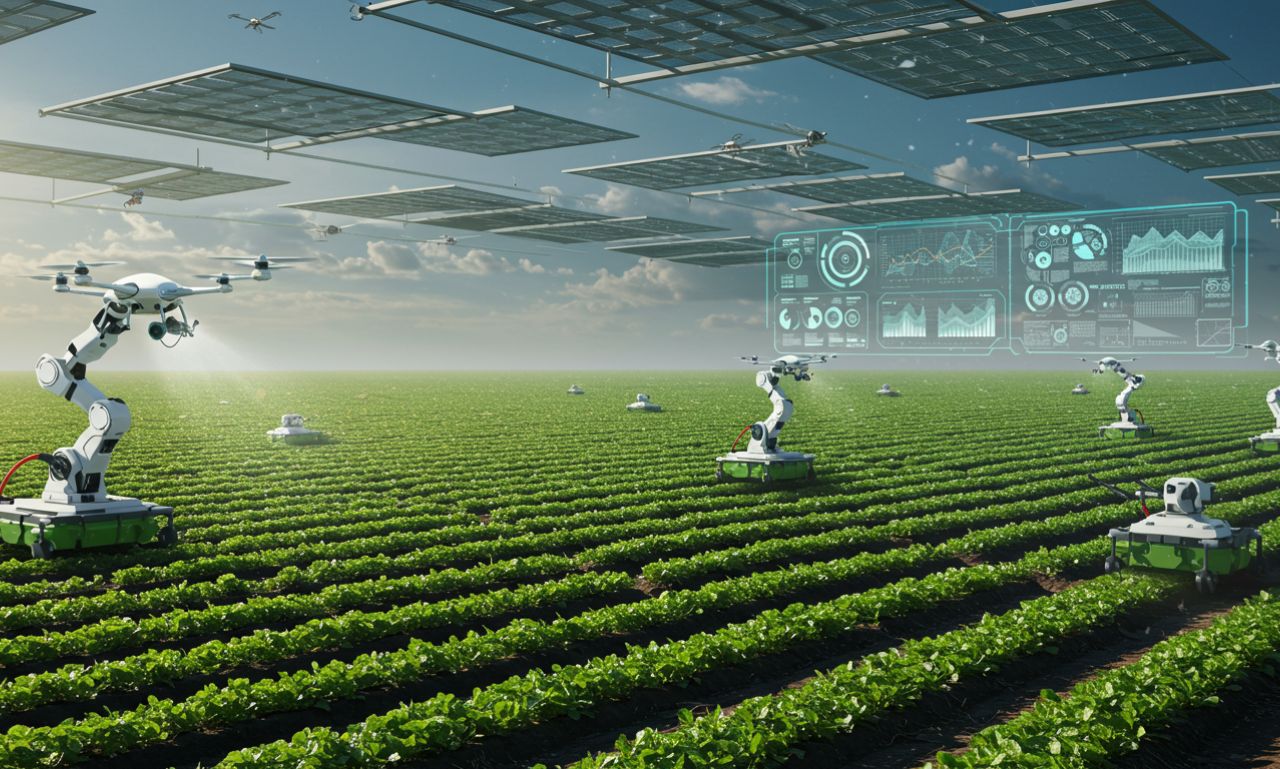The agricultural sector is undergoing a seismic shift as autonomous farming takes center stage. Gone are the days of purely manual labor—today’s farms are embracing AI-powered tractors, robotic harvesters, and smart irrigation systems. These innovations are not just futuristic concepts but real-world solutions increasing efficiency and productivity.
From self-driving tractors to drone-monitored fields, autonomous farming is redefining traditional agriculture. Farmers can now leverage precision farming tech to optimize every aspect of their operations, reducing waste and maximizing output. This revolution is set to address global food demands while minimizing environmental impact.
As technology advances, farms are becoming data-driven enterprises, where every decision—from planting to harvesting—is guided by AI and machine learning. The future of farming is autonomous, and it’s already here.
How AI is Transforming Agriculture
Artificial Intelligence is at the heart of modern agriculture, enabling smarter decision-making through real-time data analysis. Machine learning algorithms process vast amounts of information—from soil health to weather patterns—helping farmers predict crop yields and detect diseases early.
AI-powered tools like smart irrigation systems adjust water usage based on soil moisture levels, conserving resources while maintaining crop health. Similarly, predictive analytics can forecast pest outbreaks, allowing preemptive action rather than reactive measures.
These advancements are making farming more precise, sustainable, and profitable. AI isn’t just an add-on; it’s becoming the backbone of next-gen agriculture.
Case Study: John Deere’s Autonomous Tractor
John Deere’s See & Spray technology exemplifies how AI is revolutionizing farming. Using computer vision and machine learning, these autonomous tractors identify weeds in real-time and apply herbicides only where needed—reducing chemical use by up to 80%.
The 8R tractor, equipped with AI-driven automation, can plow, plant, and harvest with minimal human intervention. Its precision spraying systems ensure optimal herbicide application, cutting costs and environmental harm.
This innovation highlights how AI is not replacing farmers but empowering them with tools to work more efficiently and sustainably.
The Technology Behind Autonomous Farms
Autonomous farming relies on a synergy of cutting-edge technologies. GPS field mapping ensures precise planting and fertilizing, while IoT sensors monitor soil conditions in real time. Drones equipped with multispectral cameras provide aerial crop insights, detecting issues before they escalate.
Robotic harvesters and autonomous weeders further reduce reliance on manual labor, operating around the clock without fatigue. These systems integrate with farm data analytics platforms, offering actionable insights for better decision-making.
The result? A seamless, tech-driven farming ecosystem where efficiency and sustainability go hand in hand.
Benefits of AI-Powered Farming
The advantages of AI in agriculture are undeniable. Increased crop yields, driven by precision farming techniques, ensure higher profitability for farmers. Resource efficiency means less water, fertilizer, and pesticides are wasted, lowering costs and environmental impact.
Autonomous machinery operates 24/7, eliminating labor shortages and fatigue-related errors. Additionally, data-driven decisions optimize every stage of farming, from planting schedules to harvest timing.
Ultimately, AI-powered farming isn’t just about doing more—it’s about doing better, with fewer inputs and greater sustainability.
Challenges Facing Autonomous Agriculture
Despite its promise, autonomous farming faces hurdles. High equipment costs deter small-scale farmers, while rural connectivity issues limit real-time data access. Training farmers to use advanced agtech remains a challenge, as does navigating regulatory hurdles for new technologies.
Data privacy concerns also arise—who owns farm data collected by AI systems? Additionally, technology reliability in harsh farming conditions must be addressed to ensure consistent performance.
Overcoming these barriers will be crucial for widespread adoption of autonomous agriculture.
The Role of Big Data in Farming
Big Data is transforming farms into smart, data-driven enterprises. Farm management software analyzes historical yields, weather patterns, and soil health to optimize future crops. Predictive modeling helps farmers anticipate market demands and adjust production accordingly.
Platforms like John Deere Operations Center aggregate data from equipment, drones, and sensors, providing a holistic view of farm operations. This integration enables precision agriculture, where every decision is backed by empirical evidence.
The future of farming lies in harnessing data to maximize efficiency and sustainability.
Startups Revolutionizing Farm Tech
Agtech startups are pushing boundaries with groundbreaking innovations. Companies like FarmWise develop autonomous weeding robots, while AeroVironment offers AI-powered drone scouting for crop monitoring.
Vertical farming startups, such as Plenty, use AI to optimize indoor crop growth, reducing land and water use. These advancements highlight how precision ag startups are reshaping agriculture.
With venture capital flowing into agtech, the sector is poised for exponential growth.
Government Policies and Support
Governments worldwide are supporting autonomous farming through USDA tech grants and rural broadband initiatives. The Farm Bill includes provisions for agtech subsidies, encouraging farmers to adopt cutting-edge solutions.
However, regulatory frameworks must evolve to address data ownership and autonomous machinery safety. Policymakers play a key role in ensuring equitable access to these technologies.
Public-private partnerships will be crucial in accelerating agtech adoption.
The Future Workforce of Farming
As farms become more tech-driven, the workforce is evolving. Agtech specialists, data analysts, and robotics technicians are in high demand. Traditional farming skills are merging with tech expertise, requiring new training programs.
Educational institutions are introducing agricultural AI courses to prepare the next generation of farmers. The shift isn’t about replacing jobs but upskilling workers for a digital farming era.
The future farm workforce will be a blend of tradition and innovation.
Environmental Impact Assessment
AI-driven farming promotes sustainability by reducing chemical use, conserving water, and improving soil health. Precision agriculture minimizes carbon footprints, while climate-smart farming adapts to changing weather patterns.
Studies show autonomous tech can cut pesticide use by 50% and water waste by 30%, benefiting ecosystems. The push for eco-friendly farming aligns with global climate goals.
Sustainable agtech isn’t just profitable—it’s essential for the planet.
Global Adoption Trends
North America leads in agtech adoption, with Europe close behind. Asia is catching up, with countries like China investing heavily in smart farming.
Developing nations face challenges but stand to gain significantly from cost-effective autonomous solutions. Cross-border collaborations are accelerating global implementation.
The future of farming is a connected, worldwide movement toward efficiency.
Cost-Benefit Analysis for Farmers
While autonomous equipment requires upfront investment, the long-term ROI is compelling. Operational savings from reduced labor and inputs often offset costs within 3-5 years.
Farmers must evaluate financing options and payback periods to make informed decisions. Case studies show yield increases of 20%+ with AI adoption.
For forward-thinking farmers, the economic case for autonomy is clear.
Cybersecurity in Smart Farming
As farms digitize, cyber threats become a real concern. Hackers could target autonomous machinery or steal farm data. Encryption, secure networks, and privacy protocols are essential.
Companies like DeLaval are implementing blockchain for food traceability, enhancing security. Farmers must prioritize digital farm security to protect their operations.
A breach could disrupt entire harvests—making cybersecurity non-negotiable.
Consumer Perspectives
Consumers increasingly demand transparency in food production. AI-driven farming provides traceability, showing exactly how crops are grown.
Some worry about tech-driven agriculture replacing traditional methods, but studies show higher-quality yields with AI. Educating buyers on benefits is key to acceptance.
The future of food is smart, sustainable, and consumer-approved.
Conclusion: The Autonomous Farm of Tomorrow
Autonomous farming is no longer science fiction—it’s today’s reality. From AI tractors to data-driven decisions, technology is making agriculture smarter and greener.
While challenges remain, the benefits—higher yields, lower costs, sustainability—are undeniable. Farmers who embrace this revolution will lead the industry forward.
The future of farming is autonomous, and it’s brighter than ever.

